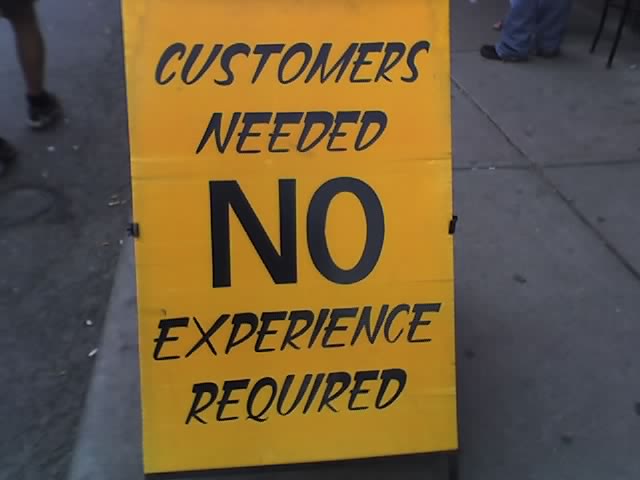|
By: Kathy Kent Toney, President of Kent Business Solutions Happy customers…what does it take to truly make them happy? Many organizations struggle with answering this question, but it's especially important in the post-pandemic world. Organizations need to do a better job of listening to their customers, not only to thrive, but survive. That’s why effective customer feedback strategies are so important, and using Voice of the Customer techniques is a great way to get there. For those of you unfamiliar with the term Voice of the Customer, here's the definition: It's an in-depth process that is used to gather customer requirements and feedback in order to provide customers with best-in-class services and/or products. And Voice of the Customer works! A study conducted by the Aberdeen Group shows that companies with VOC programs outperform all others by as much as 22%! The study was done across nine categories, including annual company revenue and customer win-back rate. When organizations have these programs in place, knowing what customers want becomes more second nature, and products can be more easily created to meet their expectations. Whether the focus is using VOC techniques to determine customer satisfaction levels with current products/services, capturing feedback to develop new products and/or services or ideally using both approaches, consistent use of VOC principles works. What Happens When You DON'T Use VOC? How many of you have been involved in New Product Development (NPD) efforts and have experienced a newly launched product failing in the market? I bet it wasn't a pretty picture! I'm sure all of us have heard of at least one such failure. I always love telling the story about one of the most epic failures of all times...the New Coke launch in 1985. It's a perfect case study of what NOT to do. Coca-Cola certainly didn't do a good job of gauging customer buy-in. And their competition took advantage of it! There's a good chance that this failure could have been avoided if VOC activities had properly occurred during NPD efforts. That is why capturing VOC is so important! In the end, a lack of VOC due diligence can result in:
What Happens When You DO Use VOC Principles? Many of these problems can be avoided when a VOC process is properly integrated into an organization. That way, a standard methodology and tools to capture customer feedback are at each employees' finger tips. Consistently gathering valuable feedback then becomes more of an everyday experience, if employees know how and when to use such tools. That’s when great things like the following can happen:
The Bottom Line Today’s post-COVID world requires an ever increasing need to listen to what customers want and expect from companies. To do otherwise is...unwise. When VOC techniques are consistently used by an organization's employees, making your customers happy will no longer a guessing game, and who doesn’t want that? Is your organization in need of such a strategy? If so, I'd love to have a conversation! Click here to schedule a 15-minute chat. Thanks for tuning in!
0 Comments
By: Kathy Kent Toney, President of Kent Business Solutions Photo by energepiccom from Pexels With all the uncertainty many businesses are facing in today’s post-pandemic world, organizations are looking at ways to cut costs and find better ways to do business. One great way to do that is to streamline business processes; however, many of these same organizations don’t know what tools to use for going about this, outside of hiring a consultant. If that’s you, then check this out the following list of 10 steps for streamlining how your team accomplishes work. For those of you who would like to a download of these same steps, click here. 1. Choose the Process Improvement (PI) Project Decide where you want to start. Tackling a smaller project at first is a good idea, particularly if your staff doesn’t have the bandwidth or PI experience. Otherwise, you can choose a more challenging project. 2. Define & Document Project Scope Determine the plan for improving the process and the timeframe you want to accomplish it in. Define it in as much detail as possible to prevent scope creep. 3. Map the Process Bring together your Subject Matter Experts (SMEs) to document the workflow based on the “Current State” of the process. It’s important to have someone facilitate this activity who is experienced in process mapping; otherwise, the basis of your whole project could be built on a faulty foundation. 4. Estimate Process & Cycle Times Estimate time frames and costs associated with the steps in the process. This is done to highlight areas where inefficiencies exist and unnecessary resources are being utilized. 5. Review the Process Map Do this to ensure accuracy and completeness of the map, making sure that the process matches reality. The end goal is to get buy-in from your SMEs. 6. Improve the Process Look at each section of the map to identify problems. The team needs to brainstorm and determine the most efficient way to perform the process that results in the most ideal outcomes for the customer. It’s also good to look at whether another person or team can more efficiently perform certain steps. 7. Develop Metrics, Controls & Tools Determine areas you want to measure and create metrics around those areas. Develop tools and documentation to support the process, and develop a plan to control/prevent process deviations. 8. Test & Revise the Process “Try Storm” the process. Take a mock run through to see if it functions as intended. If it doesn’t, make adjustments so the work will flow as intended. 9. Prep for Process Roll-Out Do these three things to ensure a successful roll-out and better process adoption:
10. Drive an Organizational Continuous Improvement Mindset Create an expectation in the organization that you’ll continue to improve processes on a regular basis. It’s definitely not a one-time event, and driving CI starts at the top! How many of you, after reading this list, are thinking that there’s no way you can undertake this on your own, without outside help? Perhaps there are some of you who might be a bit mind-blown like Aston Kutcher in this video, when you think about trying to do this on your own. Then consider this…as a process improvement expert, that’s right up my alley! I’d love to hear all about your challenges and help you brainstorm solutions. If that sounds good, click here to schedule a chat! Thanks for tuning in!
Part 1 of 3: How to Ensure a Successful Digital Transformation Journey By: Kathy Kent Toney, President of Kent Business Solutions Since the advent of COVID-19, there’s been much talk about Digital Transformation and how it can help companies. But many aren’t even sure how to start transforming their businesses through IT technologies. They may be wondering… Where do I even start? What are the best steps I can take to ensure success? In order to get answers to these questions, I recently interviewed my strategic partner, Michael Cantu’, a DT wizard with Accelerate. This is the first blog in a series of How to Ensure a Successful Digital Transformation Journey. This week we’ll be talking about how businesses can prep for a successful implementation. So, let’s get started! Kathy: Michael, it’s great to have you with us today! Michael: Great to be here! Kathy: I'd like to cover how to plan for successful Digital Transformation efforts. You mentioned to me in a previous conversation that there are four steps involved with that. But you also said that sometimes there are roadblocks to ensuring successful DT efforts which need to be removed first. One of those is not having the right culture that would embrace it. I know many businesses face this challenge today. What can these organizations do to create a culture that embraces DT efforts, if they're not in that place? Michael: The first thing is… 1. Encourage Your Team to Talk About Everyday Matters Let them know there won't be any repercussions for doing that. They should feel good about expressing their opinion. Companies do best when they have created a culture where employees can come to management anytime and talk with them about those things. A lot of times, top-level managers don't understand what's going on underneath…they just know what’s getting done or not getting done. They also may not know how it's getting done or how people feel about what they're doing. So, giving them that safety net to be able to do that is very important. The second thing is… 2. Create an Expectation You Will Be Asking Your Team For Feedback Encourage them to explore better ways to do their jobs. For instance, you may ask your employees their opinion on the best way to go about doing something or if they’ve read books that gave them ideas on how to improve processes. This helps them understand that their feedback is important. It also requires them to be an active participant within the business. The third thing is… 3. Act Upon Those items Talk with your employees about why you can't necessarily do what they're requesting right now. Make sure you give them a why. You would still keep it up on the board as a valid option, if it’s not the right time to act on it. And then the next time you start reviewing those things, ask them questions like this:
If the answers are “no”, it stays on the board. If you can move the items forward, then make it happen. Kathy: Those are some great ideas! Do you have anything else to add about creating a culture that embraces digital transformation? Michael: Yes. There has to be radical acceptance of your employees. Listening is key to understanding that everyone is different. Everyone has different thoughts, everyone comes to the table with different ideas, and there are a lot of people that are afraid of ever voicing their own opinion or idea. So, it's really important to practice that radical acceptance on an on-going basis. Kathy: I can see how "radical acceptance" is key, which leads to my next question...what happens when these efforts to create this culture don’t connect with employees who tend to be stuck in their ways and are not wanting to embrace Digital Transformation. Do you have any advice for that? Michael: I believe it's a one-on-one conversation that needs to happen with certain employees, and it starts with leadership asking themselves why those within their organization are not wanting to change. Then ask those them this same question. Sometimes leaders think employees don't want to change, but sometimes they may actually want to…there can just be a disconnect in leaders’ minds. Clearing up these misconceptions can prove helpful. And so, it's really gets down to finding out which individuals are the roadblocks in the organization that you may need to talk with about being more flexible. Ask them what you can do to help them become more adaptable. You may get some answers that are out of their control, but if you can just redirect them to what is in their control, that’s helpful. If they refuse to change, consider using the "Find and Replace" scenario. By bringing someone else in that promotes the type of culture you're looking to create within your organization, you’ll help make your DT efforts run smoother. But before you do that, I just want to say that I have rarely seen anybody that has been closed off when you talk to them, from a managerial perspective, who didn't open up when they realized their job could potentially be on the line. Either they start looking for another job…because they really don't want to change and they don't want to do what's required…or they step up. Another thing leaders can do is ask managers if their people are open and receptive to them. That may not always be the case, because if the manager has crossed them a number of times, sometimes there’s no going back…even if they ask for forgiveness, the employee won't forgive. So that’s when you can again revisit the Find and Replace method. Kathy: Those are some great pointers! Once these barriers have been addressed, how can leaders effectively plan for digital transformation initiatives? Michael: As you mentioned, there are four steps. The first is to… 1. Conduct a Needs Assessment This is really an open conversation about what the current state of the company is. An important part of this is making sure you establish the right mindset of change that you're going to be implementing within the company, because if don’t have that…talking about why change is important, how the culture is open to change, and what they can actually do…then it's going to be difficult getting through any of the other steps. It’s really great to have an outside person doing these assessments so people feel comfortable, in an anonymous kind-of-way. This assessment can be done within an individual department, or it can be a company-wide approach, depending on how big the company is. If you’re shooting for enterprise-level implementations, you're probably going to have to stick with a particular business unit. If you’re a medium-sized company, most of the time you can have these meetings across all departments and start talking through the needs that you have within the business. The second step is: 2. Take an Inventory This involves getting the actual support around the needs that were discussed within the assessment portion. So, that includes going out to the floor...talking with other personnel, asking about those questions, and really looking at what the current state of the organization is and bringing the facts back to the table. The next step is: 3. Prioritize the Change It’s really looking back at what you did from the needs assessment and looking at the actual data that came through. Then, schedule a meeting where you start to prioritize that change. It essentially involves working through prioritizing items. During the prioritization meeting, you're really looking at the aggregate of all the data that you've collected and the needs that you’ve talked about. Then, you prioritize that based off of population and revenue impact. When you’re talking about population impact, it's about how many people are actually impacted by this change, and why it is important for the organization to start undertaking this. Then pull this data forward to do the next step. 4. Make an Action Plan This is where you really start to define actions you're going to undertake to achieve and solve for those needs that were discussed and prioritized. If you have a large company with an enterprise-level implementation, you're probably going to have departmental action plans that roll up to a bigger company-wide strategy. You'll also have that at a medium-sized company, but those plans end up a little bit flatter. Kathy: Sounds good, Michael! Do you have any closing thoughts for those considering DT implementations for their companies? Michael: Yes. DT is a continuous process. If you think you need to wait to get started for any number of reasons, that will be the biggest roadblock to your success. Lots of companies are starting their DT journeys now, so my advice is to not fall behind…there’s never been a better time to get started than today! Kathy: That’s great advice, and I think that’s a wrap! Thanks for joining me today. As always, it's been a pleasure having you, Michael! Michael: Same here, thanks Kathy! If you’re interested in learning more about Digital Transformation and what it can do for your company, check out this download that outlines some benefits in relation to remote working. Thanks for tuning in!
By: Kathy Kent Toney, President of Kent Business Solutions “Nothing is impossible.”
I love this quote from Brett Veach, the General Manager of the Kansas City Chiefs. He is one of the best, if not THE best GMs in football. Winning a Super Bowl has definitely helped him achieve this distinction, but the fact that he’s the youngest NFL GM to ever do it…that’s impressive. He’s accomplished so much in three years in this role, one being the incredible players he’s brought to the team. It’s safe to say that winning it all wouldn’t have been possible without Veach’s leadership. He’s such a great study on effective leadership, so he’s my inspiration for this week’s blog. I've pulled the following four tips from a conversation that Andy Reid, Head Coach of the Chiefs, had with the media. His words describe how Veach “goes about his business," and I believe they have great application to our everyday business lives. But before I do that, here’s a link to the 3rd and 15 play that turned the tide in the Super Bowl. This never gets old with me! 1. Let’s Explore Brett has always been a voracious learner and thinks ahead. He has an amazing track record for exhaustively putting in the research to find great players. Indianapolis Colts GM Chris Ballard, who used to work with the Chiefs, put it this way: "Any time you got into a discussion with Veach about players, you knew he had done the work." Veach is well known for pestering Andy Reid with a barrage of clips if he likes a player. Brett said this about the players he looks for: “I think when you start with a relentless attitude and guys that have a passion for not just the game, but the process. These are guys that when you do your homework, they love to practice and they love to compete. . . I found out over my career if you really invest in guys that love the process, you’re going to be more successful than not. That’s where we started with those guys and it’s infectious and it carries through [the roster] from top to bottom.” Putting in the homework upfront has made all the difference in the world for Veach…he’s built a championship team full of players with champion mindsets. Lessons learned: Dig deep to understand everything you need to know about your situation or problem. By doing in-depth research before you make important decisions, you’ll lay a good foundation for your next steps. 2. Let’s Not Be Afraid to Go There Veach is “fearless”, according to Andy Reid. He’s not afraid to make wrong decisions. His persistence and boldness became evident on how he pestered Andy Reid and then-GM John Dorsey about Patrick Mahomes before the 2017 NFL draft. He kept telling Andy and his staff that he was one the best players that he had ever seen. For those of us in Chiefs Kingdom, we’re thankful that they listened! This trend continued after he became the GM. He signed Sammy Watkins, Anthony Hitchens and Harrison Butker, who all became pivotal players during the Chiefs' Super Bowl run. An even bolder move was totally blowing up the defense that caused the Chiefs to lose in the 2018 AFC Championship game. He traded away longtime players Eric Berry, Justin Houston and Derrick Thomas and brought in new Defensive Coordinator Steve Spagnuolo to reshape the new defense. When it comes to building and maintaining a championship team, Veach is unafraid to do what it takes to do just that. Lessons Learned: Once you’ve done your homework and your pathway forward is clearer, be bold in your decision making. Go after your goals with a single-mindedness to achieve success. 3. Let’s Not Say It Can’t Be Done Veach is so firmly convinced that things can be accomplished, “impossible” is not a word in his vocabulary. There were many industry experts who said it would never be possible to keep the Super Bowl winning team together, due to common spending limits that all teams must adhere to (the salary cap). Multitudes of other teams who had won the big prize were not able to repeat soon after, due to cap limitations that weren't managed well. Veach was not going to let that stop him! He set his mind on the goal and he worked relentlessly towards keeping the 2019 team together. Of course, we've yet to see if the Chiefs will win it all again. But at this point in time, the Chiefs are the team to beat, in the minds of many experts. Lessons Learned: The old adage “When there’s a will, there’s a way” applies here. Refuse to believe something can’t happen. Just make up your mind to get ‘er done and tenaciously work towards that. And this leads to the last point… 4. Let’s Find a Way To Get It Done Veach proved all the naysayers wrong by bringing back all but two of the team’s starters before the start of the season. At the same time, he gave their top-tier players, the likes of Patrick Mahomes and Chris Jones, big fat contracts. It’s pretty miraculous, because at one point the cap space (amount available to spend) was only $177! There’s no need to bore you with the details, so here's a statement by Patrick Mahomes, explaining Veach's actions in relation to these contracts: “He’s been relentless on finding a way to get it done where it’s not going to kill you down the road with deals, and so there have been a lot of man hours that he’s put into this, so my hat goes off to him.” One important factor in this whole process is a foundation of high-trust that Veach has built with his players. This really paid off during contract negotiations. Case in point...Patrick could have been paid way above the amount of his recent deal, but he was willing to strike a balance between keeping the Super Bowl winning team together and getting paid for what he’s worth. In the end, Patrick trusted Veach to do the right thing...now and in the future...by signing a 10-year deal. He believes that Veach will work with him in the future to revise the contract, if Patrick wishes to revisit it. Lessons Learned: Work towards building trusted relationships with your team. When they see your willingness to go the extra mile for them, they’ll be more willing to do the same for you. This foundation of trust will help you more quickly iron out conflicting objectives with your team so that the whole organization will be more on board to reach its goals. These principles have worked so well for the Chiefs, but the good news is that they can be also applied in businesses to build strong teams. In turn, these teams become better equipped to solve what appear to be impossible problems. However, many organizations don’t have the bandwidth to even think about implementing new ideas or initiatives to address their challenges. Or there may be so many persistent issues, they don’t know where to start. If that’s you, I’d love to help point you in the right direction! My FIRM Fitness Assessment (FFA), a 100% virtual survey tool, can help you identify areas that need attention in your business and then prioritizes where to start first on making improvements. The FFA was created in conjunction with experts in their fields who have over 300 years of combined business experience. Not only that, these same Alliance Partners of mine are available to help with any identified challenges you’d like to tackle, especially if you lack the bandwidth to address them. Interested in learning more? Then click here to schedule a quick 15-minute conversation. I’d love to fill you in on the details! |
Archives
July 2024
Categories
All
|







 RSS Feed
RSS Feed
